
Original Link: https://www.anandtech.com/show/2528
AMD Announces GAME!: Raising the Bar for Mainstream Gaming PCs
by Anand Lal Shimpi on May 19, 2008 12:00 AM EST- Posted in
- CPUs
I've been meeting with AMD a lot these days; in fact, one day last week I actually had to reschedule two separate AMD meetings because I was playing host to a few reps from, uh, AMD. With all of the negativity surrounding Phenom and a relatively quiet graphics division, it's tough to remember that I was actually excited about the ATI acquisition back when it happened. These days AMD is beginning to take shape as a total platform provider, thus when I talk to them it can be about everything from CPUs and chipsets to graphics - hence the plethora of meetings.
AMD has all of the ingredients to be a major player in the PC business. It arguably produces the best integrated graphics chipset around, is at least competitive on the discrete graphics front and, well, produces x86 CPUs. And today AMD is attempting something very industry leader-like.
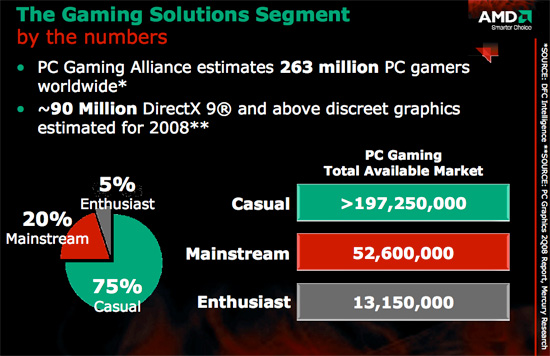
AMD views the PC gaming market as consisting of three segments: casual gamers, mainstream gamers and the enthusiasts. Casual gamers are the largest portion of the market and generally play things like Solitaire or online Flash games. The Enthusiast market is dominated by those who are already investing in good gaming PCs and have some of the highest requirements for performance/visual quality. The mainstream gaming market, however, is composed of those users who want to play more demanding games on their PCs but aren't always aware of what they need to do so.
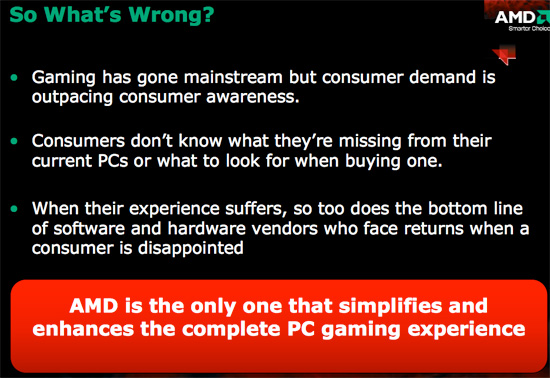
In order to help address the needs of this mainstream gaming market, AMD has established a new logo program called AMD GAME!. The idea behind AMD GAME! is to guarantee that anyone buying a PC with this logo will have a good overall gaming experience with it.
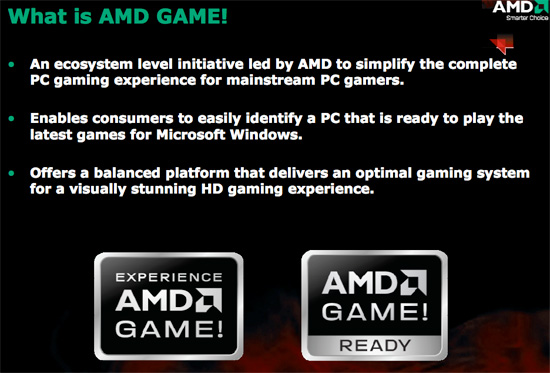
The program works like this; any PC manufacturer looking to participate in the AMD GAME! program must meet these minimum requirements:
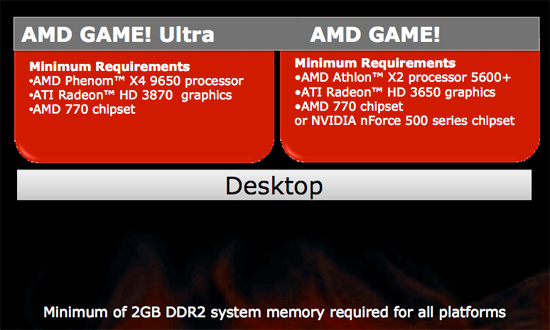
The GAME! Ultra logo actually has some pretty decent minimum requirements; a Phenom X4 9650, while not the fastest quad-core CPU available today, is more than sufficient for mainstream gaming. More importantly, the Radeon HD 3870 is a good enough GPU for the vast majority of titles today. The AMD 770 chipset choice is also a solid one.
The standard AMD GAME! logo unfortunately has more lax requirements; all you need to get this logo is an Athlon X2 5600+ and a Radeon HD 3650 as well as an AMD 770 or nForce 500 series chipset. A PC bearing the regular GAME! logo is better than your run of the mill desktop with integrated graphics, but honestly I'd prefer for there only to be one logo and for it to carry as much weight as the GAME! Ultra spec.
AMD comes up with these requirements by running a number of benchmarks internally with the following requirements:
1600 x 1200, default settings at above 30 fps (average frame rate) for AMD GAME! Ultra
1280 x 1024, default settings at above 30 fps (average frame rate) for AMD GAME!
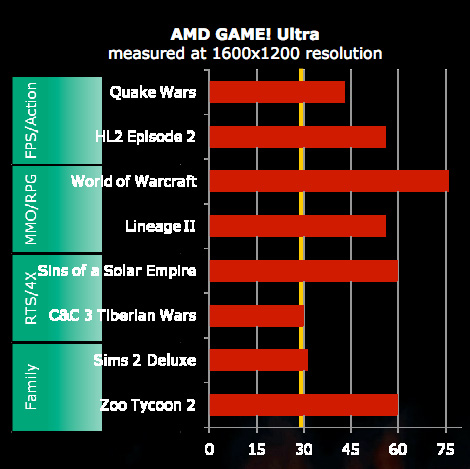
The titles AMD tests internally are Quake Wars, Half Life 2 Episode Two, World of Warcraft, Lineage II, Call of Duty 4, Sins of a Solar Empire, Command & Conquer 3, Sims 2 Deluxe and Zoo Tycoon 2. While AMD obviously runs even more benchmarks internally, these nine titles are the ones that it uses in determining the minimum hardware requirements for the GAME! and GAME! Ultra logos. The 30 fps limit isn't actually a hard limit since the vanilla AMD GAME! spec doesn't always meet it, but the goal is to get as close to it as possible.
The benchmarks themselves are manual runthroughs of the games. Each game is played for a total of 30 minutes, three times, with the average frame rates recorded and averaged. An individual tester is assigned to each game/benchmark to maintain some level of consistency. Since AMD isn't really comparing hardware here and just making sure the games meet a minimum level of experience, this relatively unscientific approach to testing works just fine. And if you're wondering, should the tester die in the middle of the demo run the results are thrown out and a new run is recorded.
AMD selects the titles for its GAME! logo program based on sales data/popularity across some of the most popular genres of PC games. The games list will be updated approximately twice a year, with the first update to the program coming in early 2009.
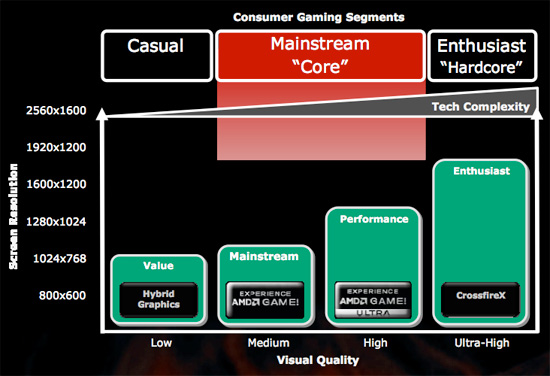
This combination of data ensures that, for the most part, people who buy PCs with the GAME! Ultra logo will get a good gaming experience on current titles, at default settings, at 1600 x 1200. Those who buy PCs with the regular GAME! logo should also be guaranteed a good experience, albeit at 1280 x 1024 instead.
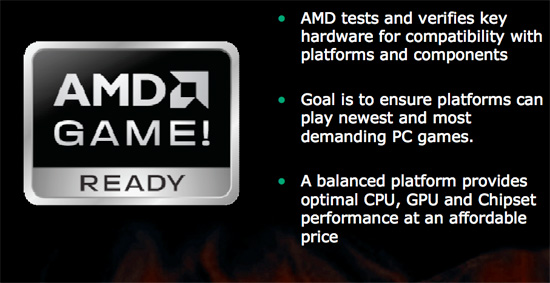
AMD will also be placing GAME! Ready logos on peripherals (e.g. mice, keyboards) that meet a separate set of standards. AMD has devised a list of requirements for these peripherals such as requiring that drivers install properly, docking stations for wireless mice and the ability to have up to 5 keys depressed at once on a gaming keyboard without triggering an error. These sorts of functional requirements are actually pretty impressive for AMD and it could mean that peripherals with the AMD GAME! Ready logo are actually a cut above the average.
Final Words
Ever since the introduction of Intel's Centrino brand, manufacturers have attempted to duplicate its success by pushing the importance of a platform. Today AMD has come the closest I've seen since then by, at least with its AMD GAME Ultra specification, putting together a list of components that can actually guarantee a good experience.
The initial goal of Centrino was that users could go out and purchase a notebook with the Centrino logo and know that they were getting a decent machine, regardless of who made it. It would have wireless, good performance and good battery life, all things that are very important to notebook users. The AMD GAME! program has similarly lofty goals; AMD wants anyone who purchases a GAME! PC or a GAME! Ready peripheral to have a good overall gaming experience.
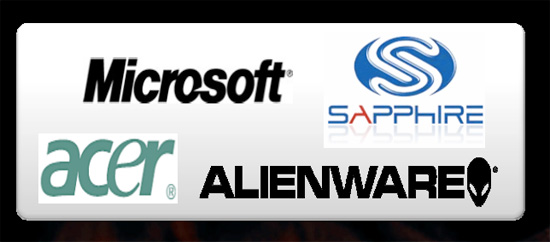
These are the only logos AMD was allowed to use in support of AMD GAME! but we're told to expect retail avability of GAME! PCs in the second half of 2008. Online system builders like Alienware and Velocity Micro should be shipping GAME! PCs immediately.
However, Centrino was successful not only because of good hardware choices, but a multi-billion dollar marketing campaign by Intel. The concern is that AMD won't have what is necessary to make AMD GAME! a success. The logo program is a good starting point, but I can't help but wonder if something like this won't truly take off until Intel tries its hand at it. Wait for Larrabee and we may see just that.







